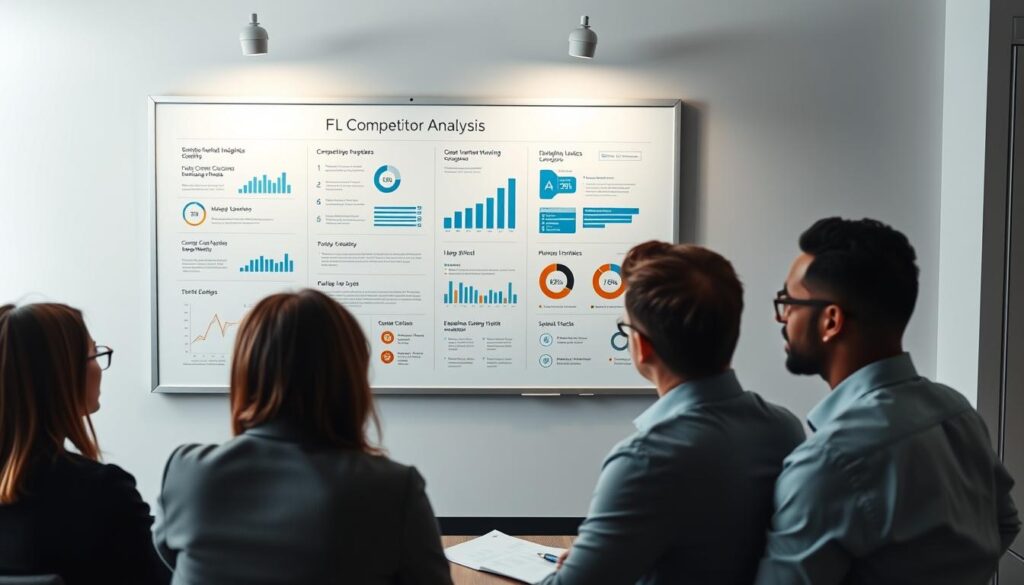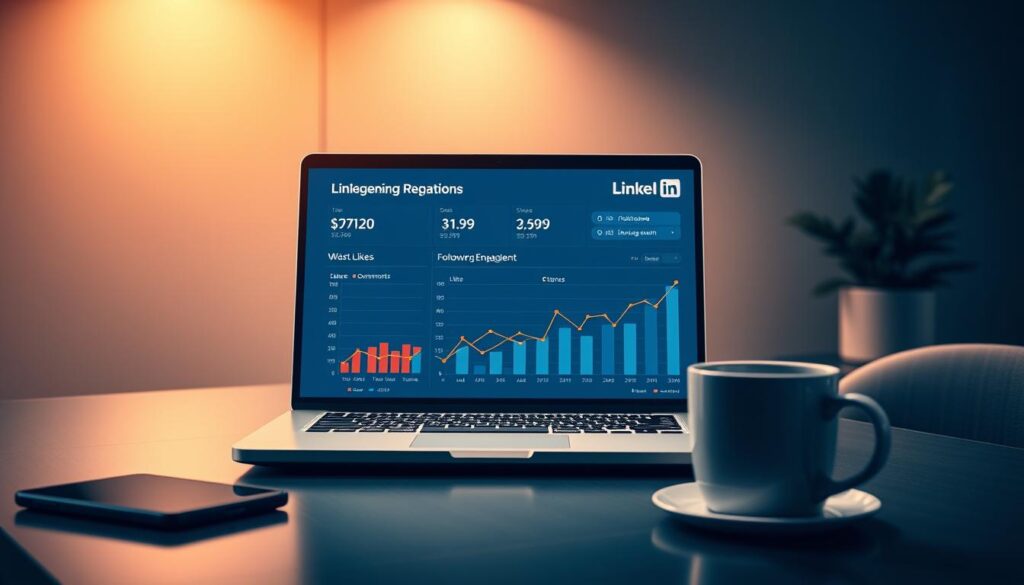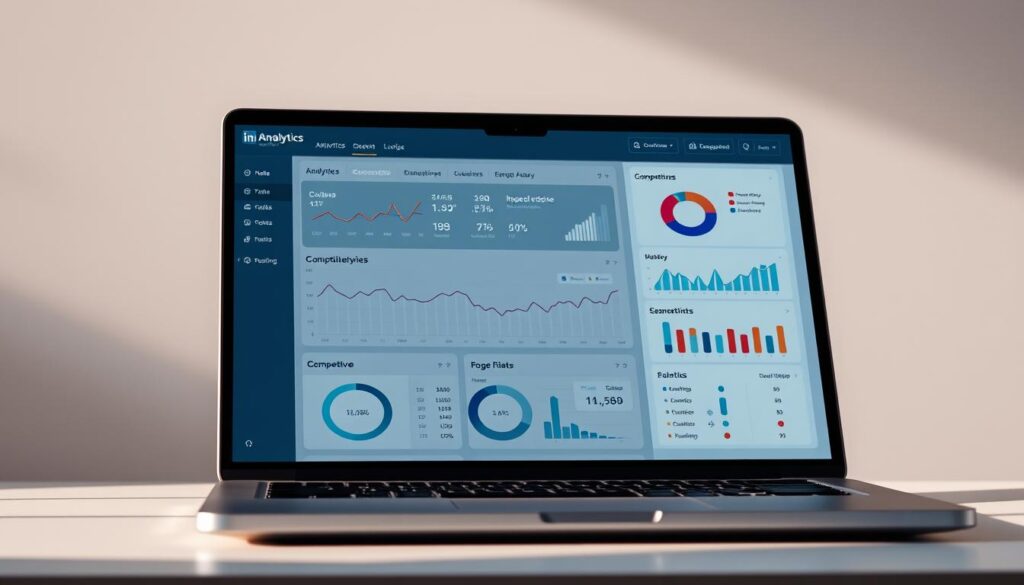Did you know that 40% of monthly active users on social platforms visit daily? This statistic highlights the immense potential of leveraging these platforms for your brand’s growth. Understanding how others in your industry perform can give you a competitive edge.
By analyzing social media behavior, you can refine your strategy and improve your results. Tracking key indicators like follower growth and post interactions helps you assess your brand’s performance. Comparing your metrics with others in your industry provides valuable insights.
Using analytics tools, you can identify trends and adjust your content strategy. This process is not a one-time task but a continuous effort to stay ahead. Start by setting the stage for a detailed analysis that leads to actionable insights.
Key Takeaways
- Analyzing social media behavior helps refine your strategy.
- Track key indicators like follower growth and post interactions.
- Compare your performance with others in your industry.
- Use analytics tools to identify trends and adjust your content.
- This process is continuous for long-term success.
Understanding LinkedIn Competitor Engagement Metrics
To truly understand your brand’s position, you need to focus on the right data points. These indicators provide a clear picture of how your content resonates with your audience. By analyzing these elements, you can identify strengths and areas for improvement.
Defining Key Engagement Metrics
Essential metrics include likes, comments, shares, and follower growth. These numbers reflect how your audience interacts with your content. Tracking these over time helps you spot trends and adjust your strategy accordingly.
For example, a high number of shares indicates that your content is valuable enough for others to spread. Similarly, consistent follower growth suggests your page is gaining traction. These insights are crucial for refining your approach.
Why Analysis Matters for Your Strategy
Analyzing these metrics is not just about numbers. It’s about understanding what drives your audience’s behavior. This knowledge helps you create content that aligns with their preferences and interests.
Consistent monitoring ensures you stay ahead of the curve. It allows you to adapt quickly to changes in audience behavior or industry trends. This proactive approach is key to long-term success.
Page-level analytics also play a vital role. They provide a deeper understanding of how your content performs compared to others in your industry. This benchmarking helps you identify gaps and opportunities for growth.
Setting Your Competitive Analysis Objectives

Setting clear objectives is the foundation of any successful analysis. Without a defined purpose, your efforts may lack direction and fail to deliver actionable insights. Start by asking yourself what you want to achieve. Are you aiming to increase your follower base, improve content reach, or refine your overall strategy?
Identifying Your Goals and KPIs
Your goals should be specific, measurable, and aligned with your broader marketing strategy. For example, if your focus is on growing your audience, track follower growth as a key performance indicator (KPI). If engagement is your priority, monitor metrics like likes, shares, and comments.
Here’s a breakdown of common KPIs to consider:
| KPI | Purpose |
|---|---|
| Follower Growth | Measure audience expansion over time. |
| Engagement Rate | Assess how well your content resonates. |
| Content Reach | Evaluate the visibility of your posts. |
| Brand Mentions | Track how often your brand is discussed. |
Choosing the right media and tools is equally important. Platforms like social listening tools can help you monitor trends and gather real-time data. These insights allow you to benchmark your performance against others in your industry.
Finally, remember that setting objectives is not a one-time task. Regularly review and adjust your goals to stay aligned with changing market dynamics. This proactive approach ensures your strategy remains effective and your brand stays ahead.
How to Initiate a LinkedIn Competitor Analysis

Starting a detailed analysis of your industry peers can unlock valuable opportunities. By understanding their strategies, you can refine your own approach and gain a competitive edge. This process involves collecting data, benchmarking performance, and extracting actionable insights.
Data Collection and Benchmarking Techniques
To begin, you need a structured method for gathering data. Manual tracking using spreadsheets is a practical starting point. This allows you to record key metrics like post interactions and follower growth. However, for a more comprehensive view, leverage native analytics tools available on the platform.
Benchmarking your performance against others is crucial. Use quantitative methods to compare metrics such as engagement rates and content reach. This helps you identify gaps and opportunities for improvement. For example, if a peer’s posts consistently receive higher interactions, analyze their content strategy for insights.
Here’s a breakdown of essential steps for effective data collection:
| Step | Description |
|---|---|
| Identify Key Metrics | Focus on metrics like likes, shares, and comments. |
| Use Native Tools | Leverage platform analytics for accurate data. |
| Manual Tracking | Record data in spreadsheets for custom analysis. |
| Benchmark Performance | Compare your metrics with industry leaders. |
Gathering views and interactions from real users is equally important. This data provides a clear picture of how your content resonates. Use these insights to refine your marketing strategy and align it with user preferences.
Finally, set up a system for regular monitoring. This ensures you stay updated on industry trends and adapt your strategy accordingly. Consistent analysis is key to maintaining a competitive edge in your business.
Measuring LinkedIn Competitor Engagement Metrics

Understanding how your audience interacts with your content is the first step to refining your strategy. By evaluating key indicators, you can gain insights into what works and what needs improvement. This process involves using both native and third-party tools to measure and interpret crucial data.
Evaluating Engagement Rates and Audience Interactions
To assess how well your content resonates, start by analyzing engagement rates. This includes tracking reactions, comments, and shares. These interactions provide a clear picture of how your audience perceives your posts.
For example, a high number of comments often indicates that your content sparks conversation. Similarly, frequent shares suggest that your posts are valuable enough for others to spread. Use these insights to adjust your strategy and create more impactful content.
Tracking Follower Growth and Content Impact
Monitoring follower growth over time is another essential step. This metric shows whether your page is gaining traction and attracting new audiences. Pair this data with post-specific performance to understand which content drives growth.
Analyzing the impact of different content types is equally important. For instance, videos often generate higher interactions compared to text posts. By identifying these trends, you can focus on creating content that aligns with your audience’s preferences.
Leveraging LinkedIn analytics is a powerful way to refine your strategy. Regularly review your profile and company page data to stay ahead of industry trends. For a deeper dive into this process, explore our guide on LinkedIn competitor analysis.
Analyzing Competitors’ Content Strategy on LinkedIn

A deep dive into posting habits reveals actionable insights for your brand. By reviewing how others structure their content, you can identify patterns that drive success. This analysis helps you refine your approach and stay ahead in your industry.
Reviewing Post Types and Frequency
Start by evaluating the types of posts your peers create. Are they using videos, articles, or infographics? Understanding their content mix helps you identify what resonates with their audience. For example, videos often generate higher interactions compared to text-based posts.
Next, assess how frequently they post. Consistency is key to maintaining audience interest. Brands that post 2-3 times per week often see better results. Timing also matters—posting during peak hours can significantly boost visibility.
Generating insightful reports is another crucial step. These summaries highlight trends in content performance over time. Use this data to benchmark your own strategy and identify areas for improvement.
Mapping your analysis across specific periods or campaigns provides a clearer picture. For instance, compare holiday-themed posts to regular content to see what drives more interactions. This approach helps you refine your strategy based on real-time data.
Finally, learn from industry leaders. Study their successful campaigns and adapt their tactics to your brand. By combining these insights with your unique voice, you can create content that truly resonates with your audience.
Leveraging LinkedIn Analytics Tools for Insightful Data

Data-driven decisions are the backbone of any successful marketing strategy. To gain a competitive edge, you need the right tools to measure and interpret your performance. Both native and third-party analytics platforms offer unique advantages, but understanding their differences is key to making the best choice for your needs.
Native Analytics Versus Third-Party Tools
Native analytics tools are built directly into platforms, providing straightforward insights into your performance. They are easy to use and offer basic metrics like post interactions and follower growth. However, their functionality is often limited compared to third-party solutions.
Third-party tools like Sprout Social and Socialinsider offer advanced features. These include cross-platform tracking, detailed reporting, and predictive analytics. They allow you to dive deeper into your data, uncovering trends that native tools might miss.
“The right analytics tool can transform raw data into actionable insights, driving your strategy forward.”
Here’s a comparison of the two types of tools:
| Feature | Native Tools | Third-Party Tools |
|---|---|---|
| Ease of Use | High | Moderate |
| Advanced Metrics | Limited | Extensive |
| Cross-Platform Support | No | Yes |
| Predictive Analytics | No | Yes |
Steps to Set Up and Use Analytics Tools
Setting up these tools is a straightforward process. Start by identifying your goals. Are you tracking engagement, monitoring growth, or analyzing content performance? Once your objectives are clear, follow these steps:
- Choose the right tool based on your needs.
- Integrate it with your accounts.
- Define key metrics to track, such as interaction rate and follower growth.
- Regularly review reports to identify trends.
Measuring qualitative data like comments and user interactions is equally important. These insights help you understand how your audience perceives your content. For example, a high number of comments often indicates that your posts spark meaningful conversations.
By leveraging these tools, you can refine your strategy and stay ahead in your industry. Whether you choose native or third-party solutions, the key is to use the data to make informed decisions that drive your brand forward.
Reviewing Competitor Performance and Benchmark Success

Benchmarking your performance against industry leaders is a critical step for growth. By analyzing how others perform, you can identify gaps in your strategy and uncover opportunities for improvement. This process involves tracking key metrics and using analytics tools to gather valuable insights.
Monitoring Follower Metrics and Engagement Trends
Start by evaluating follower growth and interaction rates. These numbers show how well your content resonates with your audience. For example, a steady increase in followers indicates your page is gaining traction. Use this data to refine your content strategy and focus on what works.
Next, track engagement trends over time. Look for patterns in likes, comments, and shares. High interaction rates often mean your posts are valuable and relevant. This valuable insight helps you create content that aligns with your audience’s preferences.
Here’s how to effectively monitor these metrics:
- Use analytics tools to compile data on follower growth and engagement.
- Compare your performance with industry benchmarks to identify gaps.
- Analyze post-specific data to understand which content drives the most interactions.
For a deeper dive into this process, explore our guide on LinkedIn competitor analysis. This resource provides actionable steps to refine your strategy and stay ahead in your industry.
Finally, assess the effectiveness of your content strategy. Are your posts achieving the desired results? Use the data to make informed adjustments and ensure your efforts align with industry standards. By consistently tracking and analyzing these metrics, you can benchmark your success and drive long-term growth.
Incorporating Data-Driven Insights Into Your LinkedIn Strategy

Transforming raw data into actionable strategies can significantly elevate your marketing efforts. By leveraging insights from analysis, you can refine your approach and stay ahead in a competitive landscape. This section explores how to integrate these insights effectively and optimize your campaigns for maximum impact.
Actionable Tactics for Optimization
Start by identifying key opportunities in your data. For example, if certain posts consistently drive more clicks, focus on replicating their success. Use trending features to capture audience attention and keep your content fresh. This approach ensures your strategy remains dynamic and relevant.
Here are some steps to optimize your campaigns:
- Analyze performance metrics to identify high-performing content.
- Incorporate trending features to enhance engagement.
- Test different content formats to see what resonates most.
“Data-driven decisions not only improve efficiency but also help you stay ahead of the competition.”
Adjusting Your Content and Campaigns
Regularly review your data to make iterative adjustments. If a particular campaign isn’t performing as expected, tweak its elements based on insights. For instance, adjust posting times or refine your call-to-action to increase clicks.
Consider these tips for refining your strategy:
- Monitor real-time data to respond quickly to trends.
- Benchmark your performance against industry standards.
- Use A/B testing to optimize content and design.
By incorporating these tactics, you can ensure your strategy remains agile and effective. Data-driven insights not only improve efficiency but also help you stay ahead of the competition.
Conclusion
Analyzing your brand’s performance is essential for staying ahead in today’s digital landscape. By leveraging social media analytics, you can gain valuable insights into what drives success. Continuous monitoring of your company page ensures you adapt to trends and refine your strategy effectively.
Using benchmarks to compare your results with industry leaders helps identify areas for improvement. Focus on key indicators like engagement rate to understand how your audience interacts with your content. This approach allows you to make data-driven decisions that enhance your brand’s visibility.
Integrating these insights into your daily practices positions your company for long-term growth. Start by setting clear goals and regularly reviewing your performance. For more detailed guidance, explore our step-by-step guide to refine your strategy and achieve measurable results.
FAQ
What are the key engagement metrics to track on LinkedIn?
Why is analyzing competitor engagement important for my strategy?
How do I set objectives for a competitive analysis on LinkedIn?
What techniques can I use to collect data for a LinkedIn competitor analysis?
How do I evaluate engagement rates and audience interactions?
What should I consider when analyzing competitors’ content strategy?
What are the differences between native LinkedIn analytics and third-party tools?
How can I incorporate data-driven insights into my LinkedIn strategy?
What actionable tactics can I use to improve my LinkedIn performance?
Source Links
- The Essentials of Social Media Competitor Analysis
- Mastering LinkedIn: Networking, Marketing and Growth Strategies
- Social Media Audience Analysis: A Guide to Understanding Your Followers | Sprinklr
- The Best LinkedIn Scheduling Tool: Boost Your Engagement Effortlessly
- 10 Strategies to Amplify your LinkedIn Reach & Presence
- Social Listening Tools for real- time Competitor analysis
- How to find and analyze competitor ads – Competitors App
- Data-Driven Recruiting: How to Use Analytics to Outshine Competitors
- How to Do Account-Based Marketing: LinkedIn Strategies for Higher Engagement | Alore
- 12 Best LinkedIn Tools for Growing an Audience (Tested)
- Measuring Social Media ROI for B2B: Key Metrics and Optimization Strategies
- LinkedIn hashtags: The complete guide for 2025
- Proven methods for streamlined social media content planning – ContentStudio Blog
- Leveraging Data Analytics: How to Build a Data-Driven Business Strategy – BrandVerge
- The Power of Social Media Analytics: A Comprehensive Guide
- Tools for Social Media Analytics: Track, and Optimize Your Strategy – Aim Technologies
- The Power of Data: Understanding Your Customers Leads to Strategic Growth – Wolf & Company, P.C.
- Building One KPI to Rule Them All
- Data is the Most Powerful Tool for [Effective] Franchise Management
- How to Create an AI Strategy That Drives Real Business Results
- Analytics for Business Leaders: How to Unlock Growth – Apollo Technical LLC
- What is Data Tracking? Everything You Need To Know – AgencyAnalytics
- Social Media Outreach Formula That Works for Everyone | Sprinklr
- AI-Enhanced Social Signals and Their Impact on SEO – Digital Hill Multimedia, Inc.
- Making Better Decisions with AI-Powered Insights